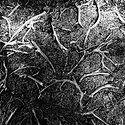I forgot to mention that in terms of intermediate highlight masking, it's often a lot easier and certainly more cost effective simply to do it via manual shading on a frosted slip sheet, or on the base of the film
back when retouch tooth was common, at least with sheet films having sufficient surface area. It's fairly easy to transfer that kind of skill set over from a Ciba or even a Graphics prepress background to DT, or visa versa. I did a lot of selective bleaching of silver masks using dilute Farmer's Reducer.
I see that David Doubley's site is still up, filled with all kinds of traditional DT info, including pan matrix use. He made the site non-downloadable, and with a finite span of availability. If that's still the case, those interested absorb what you can. He once offered all this in handbook form; I don't know if any copies are left.
There are all kinds of web and even in-print resources on making hybrid masks,separations, and enlarged contact printing negs using Pictorio film etc. I won't go into the pros and cons, and will stick with an all-darkroom workflow for this particular thread. It's also entirely feasible to make color separations from digital camera shots - again, a topic best discussed under hybrid technique, and not here. I'm as guilty as anyone else when it comes to wandering off-topic; but that could be especially confusing in this case.










